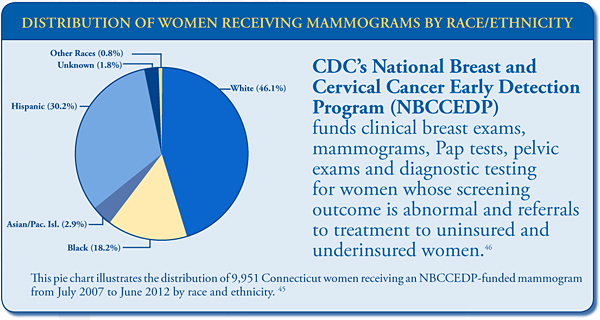Goal 2
OBJECTIVES
- Support policy, systems and environmental changes that increase the percentage of Connecticut residents receiving recommended and appropriate breast, cervical, colorectal and lung screening
- Identify and disseminate strategies and best practices to reduce disparities in access to screening services

STRATEGIC ACTIONS
- Establish systems to monitor and track the rates of cancer screenings and early detection (colonoscopy, mammography, pap tests, etc.) and to track disparities based on income, geography, race/ethnicity, sexual orientation, age and other factors
- Develop/support regional task forces to share information regarding resources to support chronic disease prevention, screening and management of best practices in collaboration with the Chronic Disease Program
- Implement policies across the health care provider workforce to increase health equity and cultural competency training
- Promote a systems change to increase the capacity for, and use of, patient navigators or community health workers for outreach to vulnerable populations for health education and improved utilization of cancer screenings
- Address socio-economic and structural barriers to cancer screening and early detection through improved awareness and use of Medicaid coverage
- Implement evidence-based physician and employer reminder systems and incentives for routine cancer screenings
Why This is Important
- Receiving cancer screenings according to recommended guidelines for breast, colorectal and cervical cancer increases the likelihood of early diagnosis, more successful treatment and reduced mortality. Colorectal cancer is preventable and beatable: Up to 60 percent of colorectal cancer deaths could be prevented if all adults 50 years and older were screened routinely.
- Socio-economic and structural barriers to cancer screening persist for high risk or vulnerable populations, including the location and timing of available services, complex paperwork, inadequate insurance, high out-of-pocket cost, transportation, language and lack of childcare.
- Patient navigation (by community health workers or patient navigators) has been found to impact cancer screening in a favorable manner. Participants in several studies who received assistance from patient navigators were significantly more likely to complete cancer screening when compared to those who did not receive navigation. (41)
- Reminder systems have been found to increase patient participation in cancer screenings. Though several studies have examined the efficacy of different approaches, most find that there is a positive correlation between reminders and timely screening.
- Racial and ethnic minorities tend to receive lower-quality healthcare than whites, even when insurance status, age, severity of disease and health status are comparable. Social inequalities, including communication barriers and provider assumptions, can affect interactions between patient and physician. Cultural competency training for providers can eliminate some of the communication barriers that arise from a lack of understanding
UNITED STATES PREVENTIVE SERVICES TASKFORCE (USPSTF) A AND B RECOMMENDATIONS:
Cervical Cancer:
The USPSTF recommends screening for cervical cancer in women ages 21 to 65 with cytology (Pap smear) every three years or, for women ages 30 to 65 years who want to lengthen the screening interval, screening with a combination of cytology and human papillomavirus (HPV) testing every five years.
Colorectal Cancer:
The USPSTF recommends screening for colorectal cancer using fecal occult blood testing, sigmoidoscopy or colonoscopy in adults, beginning at age 50 and continuing until age 75. The risks and benefits of these screening methods vary.
Breast Cancer:
The USPSTF recommends screening mammography for women ages 50 – 74. The decision to start regular, biennial screening mammography before the age of 50 should be an individual one. USPSTF recommends that women whose family history is associated with an increased risk for deleterious mutations in BRCA1 or BRCA2 genes be referred for genetic counseling and evaluation for BRCA testing (USPSTF A and B Recommendations) (44)
PROMISING PRACTICES
- Clinicians’ toolkit “How to Increase Preventive Screening Rates in Practice”
- The Guide to Community Preventive Services (The Community Guide) is a resource for evidence-based Task Force recommendations and findings about what works to improve public health
HEALTHY PEOPLE 2020 GOAL FOR PROSTATE CANCER SCREENING:
Increase the proportion of men who have discussed the advantages and disadvantages of the prostate specificantigen (PSA) test to screen for prostate cancer with their health care provider.
